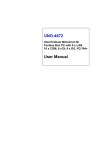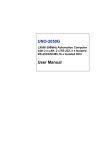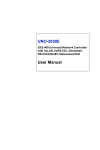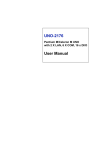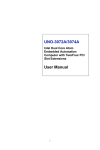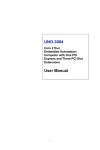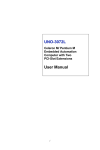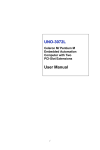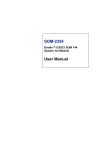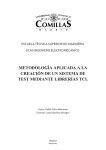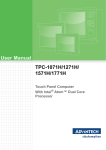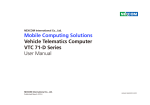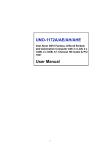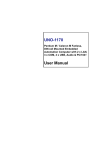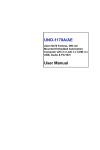Download Advantech UNO-2050G User`s manual
Transcript
UNO-2050 GX1-300 Universal Network Controller with 2 x LAN, 2 x RS-232, 2 x isolated RS-232/422/485, 16 x isolated DI/O User’s Manual Copyright notice This document is copyrighted, 2007, by Advantech Co., Ltd. All rights are reserved. The original manufacturer reserves the right to make improvements to the products described in this manual at any time without notice. No part of this manual may be reproduced, copied, translated or transmitted in any form or by any means without the prior written permission of the original manufacturer. Information provided in this manual is intended to be accurate and reliable. However, the original manufacturer assumes no responsibility for its use, nor for any infringements upon the rights of third parties which may result from such use. Acknowledgements IBM, PC/AT, PS/2 and VGA are trademarks of International Business Machines Corporation. Intel® and Pentium® are trademarks of Intel Corporation. Microsoft Windows and MS-DOS are registered trademarks of Microsoft Corp. C&T is a trademark of Chips and Technologies, Inc. All other product names or trademarks are properties of their respective owners. Part No. 2003205001 Printed in Taiwan 2nd Edition Sep. 2007 Product warranty Advantech warrants to you, the original purchaser, that each of its products will be free from defects in materials and workmanship for one year from the date of purchase. This warranty does not apply to any products that have been repaired or altered by persons other than repair personnel authorized by Advantech, or which have been subject to misuse, abuse, accident or improper installation. Advantech assumes no liability under the terms of this warranty as a consequence of such events. Because of Advantech high quality-control standards and rigorous testing, most of our customers never need to use our repair service. If an Advantech product is defective, it will be repaired or replaced at no charge during the warranty period. For out-of-warranty repairs, you will be billed according to the cost of replacement materials, service time and freight. Please consult your dealer for more details. If you think you have a defective product, follow these steps: 1. Collect all the information about the problem encountered. (For example, CPU speed, Advantech products used, other hardware and software used, etc.) Note anything abnormal and list any on-screen messages you get when the problem occurs. 2. Call your dealer and describe the problem. Please have your manual, product, and any helpful information readily available. 3. If your product is diagnosed as defective, obtain an RMA (return merchandize authorization) number from your dealer. This allows us to process your return more quickly. 4. Carefully pack the defective product, a fully completed Repair and Replacement Order Card and a photocopy proof of purchase date (such as your sales receipt) in a shippable container. A product returned without proof of the purchase date is not eligible for warranty service. 5. Write the RMA number visibly on the outside of the package and ship it prepaid to your dealer. Technical support and sales assistance If you have any technical questions about the UNO-2050 or any other Advantech products, please visit our support website at: http://www.advantech.com/support For more information about Advantech’s products and sales information, please visit: http://www.advantech.com Contents Chaper 1 1.1 1.2 1.3 1.4 1.5 Introduction ....................................................................... 2 Hardware Specifications .................................................. 3 Safety Precautions ............................................................ 6 UNO-2050 Series ............................................................. 7 Chassis Dimensions ......................................................... 8 Chaper 2 2.1 2.2 2.3 2.4 2.5 2.6 2.7 2.8 2.9 2.10 2.11 2.12 2.13 Hardware Functionality ............................. 9 UNO-2050 Peripherals .................................................. 10 COM1 ~ COM2: RS-232 Interfaces........................... 10 COM3 ~ COM4: Isolated 5-wire RS-232/422/485 Interfaces ............... 11 On-board Isolated Digital Input ................................... 12 On-board Isolated Digital Output ................................ 16 On-board Isolated Counter/Timer .............................. 18 LAN: Ethernet Connector ............................................ 24 Power Connector ............................................................ 24 LED Indicators ............................................................... 24 PS/2 Keyboard and Mouse Connector ....................... 24 VGA: VGA Display Connector ..................................... 25 Programmable LED and Buzzer for System Diagnosis ........................................................... 25 RESET: Reset Button ................................................... 26 Chaper 3 3.1 3.2 3.3 Overview ..................................................... 1 Initial Setup ............................................... 27 Insert CompactFlash Card ........................................... 28 Chassis Grounding ......................................................... 28 Connect the Power ......................................................... 29 3.4 3.5 3.6 Plug-in Screw Terminal Block Field Wiring Considerations................................................... 29 BIOS Setup and System Assignments ........................ 30 HDD Extension Flexibility .......................................... 30 Appendix A Pin Assignments ................................... 31 A.1 A.2 A.3 Board Connector and Jumpers .................................... 32 Standard RS-232 Serial Port (COM1 ~ C0M2) ......... 34 Isolated 5-wire RS-232/422/485 Serial Port (COM3 ~ COM4) .......................................................... 35 A.4 Ethernet RJ-45 Connector (LAN1~LAN2) ............... 38 A.5 Phoenix Power Connector (CN3) ................................ 39 A.6 PS/2 Keyboard and Mouse Connector (KM1) .......... 39 A.7 VGA Display Connector (VGA1) ................................. 40 A.8 CompactFlashTM Master/Slave Jumper Setting (JP2) ................................................................................. 41 A.9 Enhanced IDE connctor (CN2) .................................... 42 A.10 LCD connector (CN7, Reserved) ............................... 43 A.11 UNO-2050 Control Register ........................................ 45 Figures Figure 1-1: Chassis dimensions ................................................................ 8 Figure Figure Figure Figure Figure Figure Figure Figure Figure 2-1: 2-2: 2-3: 2-4: 2-5: 2-6: 2-7: 2-8: 2-9: UNO-2050 front panel ............................................................ 10 UNO-2050 rear panel ............................................................. 10 Digital input connector pin assignments ............................... 12 Isolated digital input connection ............................................. 13 Digital output connector pin assignments ............................. 16 Isolated digital output connection .......................................... 17 Counter 0 function block ......................................................... 19 Counter 1 function block ......................................................... 20 32-bit Counter function block .................................................. 20 Figure 3-1: Chassis Grounding connection ............................................. 28 Figure A-1: Figure A-2: Figure A-3: UNO-2050 connector and jumper locations (Top View) ........ 32 UNO-2050 connector and jumper locations (Bottom View) .. 32 RS-485 Wiring topology .......................................................... 38 Tables Table Table Table Table Table Table Table Table Table Table Table Table Table Table Table Table Table Table 2-1: 2-2: 2-3: 2-4: 2-5: 2-6: 2-7: 2-8: 2-9: 2-10 2-11 2-12 2-13 2-14: 2-15: 2-16: 2-17: 2-18: Table A-1: Table A-2: Table A-3 Table A-4: Table A-5: Table A-6: Table A-7: Table A-8: Table A-9: Table A-10: Table A-11: Table A-12: Table A-13: Serial ports default setting ...................................................... 11 Digital input connector signal description .............................. 12 Interrupt control register bit map ............................................ 14 Interrupt disable/enable control bit values ............................. 15 Interrupt triggering edge control bit values ............................. 15 Interrupt flag bit values ............................................................ 15 Digital output connector signal description ........................... 16 JP12 Digital output power on configuration ........................... 17 Counter/Timer control register bit map .................................. 18 Counter clock source control bit ............................................. 21 Counter internal clock control bit ............................................ 21 Counter gate source control bit .............................................. 22 Counter output destination ..................................................... 22 Counter interrupt flag control bit ............................................. 23 32-bit counter control bit ......................................................... 23 LED and Buzzer control register bit map ................................ 25 Programmable LED control bit ............................................... 26 Programmable Buzzer control bit ........................................... 26 UNO-2050 connectors and jumpers ...................................... 33 RS-232 serial port pin assignments ...................................... 34 Isolated 5-wire RS-232/422/485 serial port pin assignments ..................................................................... 35 Jumpers to select 5-wire RS-232/422/485 ............................ 35 RS-485 auto flow control mode and RS-422 master/slave mode selection ....................................................................... 36 JP7 RS-422/485 terminal resistor setting .............................. 37 Ethernet RJ-45 connector pin assignments .......................... 38 Phoenix power connector pin assignments .......................... 39 Keyboard and Mouse connector pin assignments ................ 39 VGA adaptor cable pin assignments ..................................... 40 IDE hard drive connector ........................................................ 42 LCD connector ........................................................................ 43 UNO-2050 control register ..................................................... 45 CHAPTER 1 UNO-2050 Overview This chapter gives background information on the UNO-2050. It shows you the UNO-2050 overview and specifications. Sections include: • Introduction • Hardware Specifications • Safety Precautions • UNO-2050 Series • Chassis Dimension 1.1 Introduction Are you looking forward to a suitable embedded Application Ready Platform (ARP) that could shorten your development time and offer rich networking interfaces to fulfill your extensive needs in different kind of projects? Advantech Universal Network Controller (UNO-2000 series) is your ANSWER concentrating the services on Networkenabled Application Ready Platform total solution. Leveraging field-approved and worldwide-awareness real-time OS technology, Advantech UNO-2000 series provides Windows CE .NET ready solution and support several standard networking interfaces, such as Ethernet, Wireless LAN, RS-232/422/485 and so on. Because of its openness, great expansion capability and reliable design – fanless and diskless, Advantech UNO-2000 series becomes an ideal embedded platform to implement custom applications in diversified applications. 2 UNO-2050 User's Manual 1.2 Hardware Specifications CPU: NS Geode GX1-300 MHz Chipset: NS CS5530A BIOS: AWARD 256 KB FLASH BIOS RAM: 64/128 MB SDRAM on board VGA: Supports VGA and VESA - Display memory: 1 ~ 4 MB share memory, set in BIOS - CRT display mode: Non-interlaced CRT monitors resolutions up to 1280 x 1024 @ 256 colors or 1024 x 768 @ 16 bpp - DB-15 VGA connector Serial Port: Two standard RS-232 ports - Data bits: 5, 6, 7, 8 - Stop bits: 1, 1.5, 2 - Parity: none, even, odd - Speed: 50 ~ 115.2 Kbps - Data signals: TxD, RxD, RTS, CTS, DTR, DSR, DCD, RI, GND - Max data distance: 50 feet (15.2 meters) Serial port: 2 x 5-wire RS-232/422/485 - Automatic RS-485 data flow control - 2000 VDC surge protection and 1500 VDC isolation - Stop bits: 1, 1.5, 2 - Parity: non, even, odd - RS-232 Speed: 50 ~ 230.4 Kbps - RS-422/485 speed: 50 ~ 921.6 Kbps - 5-wire RS-232 data signals: TxD, RxD, RTS, CTS, GND - RS-422 data signals: TxD+, TxD-, RxD+, RxD-, GND Chapter 1 UNO-2050 Overview 3 - RS-485 data signals: DATA+, DATA-, GND - RS-232 max data distance: 50 feet (15.2 meters) - RS-422/485 max data distance: 4000 feet (1200 meters) - Plug-in screw-terminal block: Accepts 0.5 mm2 to 2.5 mm2 , 1 - #12 or 2 - #14 to #22 AWG Ethernet Port: Dual 10/100Base-T Ethernet - LAN chip: Realtek 8139C chipset supports - LED on the front side 8-ch isolated digital input: (DI0~DI7) - 2,000 VDC isolation, 2000 VDC ESD protection and 70 VDC over-voltage protection - 0 ~ 50 VDC input range and 10 KHz speed - Input Voltage - Logic 0: 0 ~ 3 VDC - Logic 1: 10 ~ 50 VDC - Input Current - 10 VDC: 1.7 mA (typical) - 12 VDC: 2.1 mA (typical) - 24 VDC: 4.4 mA (typical) - 48 VDC: 9.0 mA (typical) - 50 VDC: 9.4 mA (typical) - Interrupt handling capability - Plug-in screw-terminal block: Accepts 0.5 mm2 to 2.5 mm2 , 1 - #12 or 2 - #14 to #22 AWG 8-ch isolated digital output: (DO0 ~ DO7) - 2,000 VDC isolation and 200 mA max / channel sink current - Keep output status after system hot reset - 5 ~ 40 VDC output range and 10 KHz speed - Plug-in screw-terminal block: Accepts 0.5 mm2 to 2.5 mm2 , 1 - #12 or 2 - #14 to #22 AWG 4 UNO-2050 User's Manual Two 16-bit counters/timers: - Counter source: DI6 & DI7, Pulse output: DO6 & DO7 - Can be cascaded as one 32-bit counter/timer - Down counting, Preset counting value - Interrupt handling, speed: 40 KHz - Timer time base: 100 KHz, 10 KHz, 1 KHz, 100 Hz SSD: One Type I / Type II CompactFlashTM card slot inside the chassis HDD: Offer HDD extension kit for installation of one standard 2.5" HDD. LED: One power LED, one IDE LED, one programmable LED and one programmable buzzer Keyboard/Mouse connector: Mini-DIN connector supports PS/2 keyboard and a PS/2 mouse Power supply voltage: 9 ~ 36 VDC , reversed wiring protection Power Consumption: 0.6 A max under +24 V power input or 1.2 A max. under +12 V power input Power Requirement: 1A typical under +24 V power input or 1.5 A typical under +12 V power input Operating temperature: -10 ~ 55°C (14 ~ 131°F) Chassis size: 164.8 mm (W) x 106.5 mm (L) x 35.5 mm (H) (6.5" x 4.2" x 1.4") Weight: 0.8 kg Chapter 1 UNO-2050 Overview 5 1.3 Safety Precautions The following sections tell how to make each connection. In most cases, you will simply need to connect a standard cable. All of the connector pin assignments are shown in Appendix A. Warning! Always disconnect the power cord from your chassis whenever you are working on it. Do not connect while the power is on. A sudden rush of power can damage sensitive electronic components. Only experienced electronics personnel should open the chassis. Caution! 6 Always ground yourself to remove any static electric charge before touching UNO-2050. Modern electronic devices are very sensitive to static electric charges. Use a grounding wrist strap at all times. Place all electronic components on a static-dissipative surface or in a static-shielded bag.. UNO-2050 User's Manual 1.4 UNO-2050 Series There are two products in UNO-2050 series listed as below: • UNO-2050: UNO-2050 hardware platform • UNO-2050CE: UNO-2050 hardware platform with Windows CE OS (built in 32MB CompactFlashTM card) Packing list Before installing your board, make sure that the following materials have been received: Common parts: • Warranty certificate • Software Supporting CD-ROM • 6P-6P-6P 20cm KB and PS/2 Mouse Y cable (P/N: 1700060202) • Plug-in Block 2P Female (P/N 1652002205) • DIN-rail mounting accessory (1997001110, 1997001120, 1997001130, 1997001140) For UNO-2050CE only: • Built in 32 MB CompactFlashTM card with Microsoft Windows CE OS • End User License Agreement for Windows CE If any of these items are missing or damaged, contact your distributor or sales representative immediately. Chapter 1 UNO-2050 Overview 7 1.5 Chassis Dimensions Figure 1-1: Chassis dimensions 8 UNO-2050 User's Manual CHAPTER 2 Hardware Functionality This chapter shows how to set up the UNO-2050’s hardware functions, including connecting peripherals, switches and indicators. Sections include: • UNO-2050 Peripherals • COM 1 ~ COM 2: RS-232 Interfaces • COM 3 ~ COM 4: Isolated 5-wire RS-232/ 422/485 Interfaces • On-board Isolated Digital Input • On-board Isolated Digital Output • On-board Isolated Counter/Timer • LAN: Ethernet Connector • Power Connector • LED Indicators • PS/2 Keyboard and Mouse Connector • VGA: VGA Display Connector • Programmable LED and Buzzer for System Diagnosis • RESET: Reset Button 2.1 UNO-2050 Peripherals The following two figures show the connectors on UNO-2050. The following sections give you detail information about function of each peripheral. Figure 2-1: UNO-2050 front panel Figure 2-2: UNO-2050 rear panel 2.2 COM1 ~ COM2: RS-232 Interfaces The UNO-2050 offers two standard RS-232 serial communication interface ports, and they are COM1 and COM2. Please refer to A.2 for its pin assignments. 10 UNO-2050 User's Manual 2.3 COM3 ~ COM4: Isolated 5-wire RS-232/ 422/485 Interfaces The UNO-2050 offers two isolated 5-wire RS-232/422/485 serial communication interface ports, and they are COM3 and COM4. The connector type of COM3 and COM4 is screw-terminal block that it’s easy for wiring without additional daughter board. Each port can be configured individually to either RS-232, RS-422 or RS-485 by using on-board jumpers (see Appendix A.3), and Table 2-1 lists the default setting of each port. Table 2-1: Serial ports default setting COM Port COM3 COM4 Default Setting RS-485 RS-485 16C954 UARTs with 128-byte standard Advantech UNO-2050 comes standard with Oxford OX16PCI964 UARTs containing 128 bytes FIFOs. These upgraded FIFOs greatly reduce CPU overhead and are an ideal choice for heavy multitasking environments. Automatic Data Flow Control Function for RS-485 In RS-485 mode, UNO-2050 automatically senses the direction of incoming data and switches its transmission direction accordingly. Therefore no handshaking signal (e.g. RTS signal) is necessary. This feature lets you simply and quickly build an RS-485 network with just two wires. More importantly, application software previously written for half duplex RS-232 environments can be maintained without need for modification. IRQ and Address Setting The IRQ and I/O address range are both assigned by BIOS. COM3, COM4 serial ports and on-board digital I/O use the same IRQ. Chapter 2 Hardware Functionality 11 2.4 On-board Isolated Digital Input The UNO-2050 has 8 isolated digital input channels designated DI0~DI7. Pin Assignment DI 6 DI 7 DI 4 DI 5 DI 3 COM DI 2 DI 0 DI 1 The connector type of UNO-2050 is plug-in screw terminal block that enables you to connect to field I/O devices directly without additional accessories. Figure 2-3 and Table 2-2 shows its pin assignment as well as signal description. Isoated DI Figure 2-3: Digital input connector pin assignments Table 2-2: Digital input connector signal description Signal Name DI <0...7> COM Reference COM - Direction Input Input Description Isolated digital input signals External common input of DI Isolated Inputs Each of isolated digital input channels accepts 10 ~ 50 VDC voltage inputs, and accepts bi-directional input. It means that you can apply positive or negative voltage to an isolated input pin (Vin). All eight channels share one common pin (COM). Figure 2-4 shows how to connect an external input source to one of the UNO-2050’s isolated input channels. 12 UNO-2050 User's Manual Please note that DI4 and DI5 may be configured as Counter 0 and Counter 1’s gate control pins; DI6 and DI7 may be configured as Counter 0 and Counter 1’s clock input pins. Please refer to “section 2.6” for detail External Internal PC 5V IDI channels Protection Circuit S Vin Bi-direction diode (COM) Figure 2-4: Isolated digital input connection Interrupt function of the DI signals DI0 and DI1 can be used to generate hardware interrupts. A user can setup the configuration of interrupts by programming the interrupt control register. The channels are connected to the interrupt circuitry. Users can disable/enable interrupt function, select trigger type or latch the port data by setting the Interrupt Control Register of the UNO-2050. When the interrupt request signals occur, then the software will service these interrupt requests by ISR (Interrupt Service Routine). The multiple interrupt sources provide the card with more capability and flexibility. Chapter 2 Hardware Functionality 13 IRQ Level The IRQ level is set automatically by the system BIOS. There is no need for users to set the IRQ level. Only one IRQ level is used although it has several interrupt sources. Interrupt Control Register The Interrupt Control Register controls the function and status of each interrupt signal source. Table 2-3 shows the bit map of the Interrupt Control Register. The register is readable/writable register. While being written, it is used as a control register; and while being read, it is used as a status register. Table 2-3: Interrupt control register bit map Base Address 7 Base+02H R/W Base+03H R/W Base+07H R/W 6 5 4 3 2 1 0 Interrupt Enable Control/Status Register DI1EN DI0EN Interrupt Triggering Edge Control/Status Register DI1TE DI0TE Interrupt Flag/Clear Register DI1F DI0F DI0EN & DI1EN: DI0 & DI1 Interrupt disable/enable control bit DI0TE & DI1TE: DI0 & DI1 Interrupt triggering edge control bit DI0F & DO1F: DI0 & DI1 interrupt flag bit Interrupt Enable Control Function The user can choose to enable or disable the interrupt function by writing its corresponding value to the interrupt disable/enable control bit in the interrupt control register, as shown in Table 2-4 14 UNO-2050 User's Manual Table 2-4: Interrupt disable/enable control bit values DI0EN & DI1EN Interrupt disable/enable control 0 Disable 1 Enable Interrupt Triggering Edge Control The interrupt can be triggered by a rising edge or a falling edge of the interrupt signal, as determined by the value in the interrupt triggering edge control bit in the interrupt control register, as shown in Table 2-5. Table 2-5: Interrupt triggering edge control bit values DI0TE & DI1TE 0 1 Triggering edge of interrupt signal Falling edge trigger Rising edge trigger Interrupt Flag Bit The interrupt flag bit is a flag indicating the status of an interrupt. It is a readable/writable bit. To find the status of the interrupt, you have to read the bit value; to clear the interrupt, you have to write “1” to this bit. This bit must first be cleared to service the next coming interrupt. Table 2-6: Interrupt flag bit values DI0F & DI1F Read Write 0 1 0 1 Interrupt Status No interrupt Interrupt occur Don’t care Clear interrupt Chapter 2 Hardware Functionality 15 2.5 On-board Isolated Digital Output The UNO-2050 has 8 isolated digital output channels designated DO0~DO7. Pin Assignment COM D07 D06 D05 D04 D03 D02 D01 D00 GND The connector type of UNO-2050 is plug-in screw terminal block that enables you to connect to field I/O devices directly without additional accessories. Figure 2-5 and Table 2-7 shows its pin assignment as well as signal description. Isoated DO Figure 2-5: Digital output connector pin assignments Table 2-7: Digital output connector signal description Signal Name Reference Direction Description DO <0...7> GND Output Isolated digital output signals COM - Input External common output of DO GND - - Isolated ground Power On Configuration Default configuration after power on or hardware reset is to set all the isolated digital output channels to open status (the current of the load can’t be sink) so that users need not worry about damaging external devices during system startup or reset. When the system is hot reset, then the status of isolated digital output channels are selected by jumper JP12. Table 2-8 shows the configuration of jumper JP12. 16 UNO-2050 User's Manual Table 2-8: JP12 Digital output power on configuration JP12 Power on configuration after hot reset Default configuration Keep last status after hot reset Isolated Outputs Each of isolated output channels comes equipped with a Darlington transistor. All eight output channels share common collectors and integral suppression diodes for inductive loads. Please note that if an external voltage (5 ~ 40 VDC) is applied to an isolated output channel while it is being used as an output channel, the current will flow from the external voltage source to the UNO-2050. Please take care that the current through each DO pin not exceed 200 mA. Figure 2-6 shows how to connect an external output load to the UNO2050’s isolated outputs. Please note that DO6 and DO7 may be configured as Counter 0 and Counter 1’s output pins, please refer to “section 2.6” for detail. ISO 5V Internal External COM R IDO0....7 Load0....7 VDC 5~40VDC IGND R R R R E1 Figure 2-6: Isolated digital output connection Chapter 2 Hardware Functionality 17 2.6 On-board Isolated Counter/Timer The UNO-2050 uses one 82C54 programmable timer/counter chip that includes three independent 16-bit down counters: counter 0, counter 1 and counter 2. Counter 0 and counter 1 are for users, and counter 2 is specified for the system and can’t be used by user. Each counter has clock input, gate input and pulse output. They can be programmed to count from 2 up to 65535 or cascaded into one 32-bit counter. The UNO-2050 has 2 isolated counter input channels designated DI6 and DI7 or 2 isolated timer output channels designated DO6 and DO7. Therefore, you can set each counter of 82C54 as counter function or timer function. Counter/Timer Control Register The Counter/Timer Control Register controls the function and status of each counter/timer signal source. Table 2-9 shows the bit map of the Counter/Timer Control Register. The register is readable/writable register. While being written, it is used as a control register; and while being read, it is used as a status register. Table 2-9: Counter/Timer control register bit map Base Address 7 6 5 4 3 Base+07H R/W CTR1F 0 CTR0F 82C54 Chip Counter1 Register Base+09H R/W 82C54 Chip Control Register Base+0BH R/W Counter0 Start Control / Output Status Register Base+0CH R/W CTR0Out CTR0Gate Counter1 Start Control / Output Status Register Base+0DH R/W CTR1Out CTR1Gate Counter0 Setting Register Base+0EH R/W 18 1 82C54 Chip Counter0 Register Base+08H R/W Base+0FH R/W 2 Interrupt Flag/Clear Register CTR0IntSet CTR0OutSet CTR0GateSet CTR0CLKSet Counter1 Setting Register CTR32Set S1 UNO-2050 User's Manual S0 CTR1IntSet CTR1OutSig CTR1GateSig CTR1CLKSig CTR0F & CTR1F: Counter 0 & Counter 1 interrupt flag bit CTR0Gate & CTR1Gate: Counter 0 and Counter 1 gate control bit CTR0Out & CTR1Out: Counter 0 and Counter 1 output status bit CTR0CLKSet & CTR1CLKSet: Counter 0 and Counter 1 clock source control bit CTR0GateSet & CTR1GateSet: Counter 0 and Counter 1 gate source control bit CTR0OutSet & CTR1OutSet: Counter 0 and Counter 1 output destination control bit CTR0IntSet & CTR1IntSet: Counter 0 and Counter 1 interrupt control bit S0 & S1: Counter 0 and counter 1 internal clock control bit CTR32Set: Cascaded 32-bit counter control bit Counter 0 Function Block CTR0GateSet DI4 CTR0OutSet CTR0OutSet=1 Output to DO6 CTR0GateSet=1 Out Gate CTR0Gate DI6 CTR0OUT CTR0GateSet=0 CTR0CLKSet DO6 CTR0OutSet=0 Disable Counter 0 CTR0IntSet CTR0OutSet=0 Diable Interrupt CTR0CLKSet=1 CLK Interrupt Circuit CTR0OutSet=1 Enable Interrupt 100KHz 10KHz 1KHz 100Hz CTR0F CTR0CLKSet=0 S1S0 Figure 2-7: Counter 0 function block Chapter 2 Hardware Functionality 19 Counter 1 Function Block CT R 1GateS et DI 5 CT R 1OutS et CT R 1OutS et=1 Output to DO6 CT R 1GateS et=1 Out Gate CT R 1Gate CT R 1OUT CT R 1GateS et=0 CT R 1CL K S et DI 7 DO7 CT R 1OutS et=0 Dis able CT R 1I ntS et Counter 1 CT R 1OutS et=0 Diable I nterrupt CT R 1CL K S et=1 Inter rupt Circuit CL K CT R 1OutS et=1 E nabl e Inter r upt 100K Hz 10KH z 1K Hz 100H z CT R 1F CT R 1CL K S et=0 S 1S 0 Figure 2-8: Counter 1 function block 32-bit Counter Function Block (CTR32Set=1) CT R 1GateS et DI 5 CT R 1OutS et CT R 1OutS et=1 Output to DO6 CT R 1GateS et=1 Out Gate CT R 1Gate CT R 1OUT CT R 1GateS et=0 Cas caded 32-bit Counter CT R 1CL K S et DI 7 CT R 1I ntS et CT R 1OutS et=0 Diable I nterr upt CT R 1CL KS et=1 CL K Inter rupt Circuit CT R 1OutS et=1 E nabl e Inter r upt 100K Hz 10KH z 1K Hz 100H z CT R 1CL KS et=0 S 1S 0 Figure 2-9: 32-bit Counter function block 20 DO7 CT R 1OutS et=0 Dis able UNO-2050 User's Manual CT R 1F Counter clock source There are two clock sources available for the user counters by setting counter clock control bits - CTR0CLKSet and CTR1CLKSet. Table 2-10 Counter clock source control bit Counter clock control bit 0 CTR0CLKSet 1 0 CTR1CLKSet 1 Internal clock (default) External clock from digital input 6 (DI6) channel Internal clock (default) External clock from digital input 7 (DI7) channel Counter internal clock There are four frequency options to choose according to applications, and it’s set by internal clock control bits - S0 and S1. Table 2-11 Counter internal clock control bit S1 S0 Time base 0 0 100KHz (default) 0 1 10 KHz 1 0 1 KHz 1 1 100 Hz Chapter 2 Hardware Functionality 21 Counter gate source The gate sources you select determine what kind of gate input signal to enable your counter/timer when receiving clock input. There are two gate sources available for the user counters by setting gate source control bits - CTR0GateSet and CTR1GateSet. Table 2-12 Counter gate source control bit Gate Source control bit CTR0GateSet CTR1GateSet 0 Gate source from “CTR0Gate” control bit (Default) 1 Gate source from digital input 4 (DI4) channel 0 Gate source from “CTR1Gate” control bit (Default) 1 Gate source from digital input 5 (DI5) channel Counter output destination You can choose the output destination of counter 0 and counter 1 by setting “Output Destination control bits” - CTR0OutSet and TR1OutSet. Table 2-13 Counter output destination Output Destination control bit CTR0OutSet CTR1OutSet 22 0 Output destination to “CTR0Out” status bit (Default) 1 Output destination to “CTR0Out” status bit and digital output 6 (DO6) channel 0 Gate destination to “CTR1Out” status bit. (Default) 1 Output destination to “CTR1Out” status bit and digital output 7 (DO7) channel UNO-2050 User's Manual Counter interrupt flag The interrupt flag bit is a flag indicating the status of an interrupt. It is a readable/writable bit. To find the status of the interrupt, you have to read the bit value; to clear the interrupt, you have to write “1” to this bit. This bit must first be cleared to service the next coming interrupt. Besides, you can choose if counter 0 or counter 1 generate interrupt signal by configuring “CTR0IntSet” and “CTR1IntSet” control bit. Table 2-14: Counter interrupt flag control bit Counter Interrupt Status CTR0F, CTR1F Read Write 0 No interrupt 1 Interrupt occur 0 Don’t care 1 Clear interrupt CTR0IntSet, CTR1IntSet Counter Interrupt Control 0 Disable (Default) 1 Enable Cascaded 32-bit Counter You can also cascade counter 0 and counter 1 together as one 32-bit counter/timer, and it’s configured by the control bit - CTR32Set. Table 2-15: 32-bit counter control bit 0 1 32-bit counter control bit Disable (Default) Cascade counter 0 and counter 1 into one 32-bit counter Chapter 2 Hardware Functionality 23 2.7 LAN: Ethernet Connector The UNO-2050 is equipped with two Realtek RTL8139C Ethernet LAN controller that is fully compliant with IEEE 802.3u 10/100Base-T CSMA/CD standards. The Ethernet port provides a standard RJ-45 jack on board, and LED indicators on the front side to show its Link (Yellow LED) and Active (Green LED) status. Please refer to A.4 for its pin assignments. 2.8 Power Connector The UNO-2050 comes with a Phoenix connector that carries 9 ~ 36 VDC external power input, and features reversed wiring protection. Therefore, it will not cause any damage to the system by reversed wiring of ground line and power line. Please refer to A.5 for its pin assignments. 2.9 LED Indicators There are two LEDs on the UNO-2050 front panel for indicating system status: PWR LED is for power status and IDE LED is for IDE bus status. 2.10 PS/2 Keyboard and Mouse Connector The UNO-2050 provides a PS/2 keyboard and PS/2 mouse connector. A 6-pin mini-DIN connector is located on the panel of the UNO-2050. The UNO-2050 comes with an adapter to convert from the 6-pin miniDIN connector to two 6-pin mini-DIN connectors for PS/2 keyboard and PS/2 mouse connection. Please refer to Appendix A.6 for its pin assignments. 24 UNO-2050 User's Manual 2.11 VGA: VGA Display Connector The UNO-2050 provides a VGA controller for a high resolution VGA interface. It supports VGA and VESA, up to 1280 x 1024 @ 8 bpp and 1024 x 768 @ 16bpp resolution and up to 4 MB share memory. The VGA interface is reserved for system testing and debugging. 2.12 Programmable LED and Buzzer for System Diagnosis In a headless application (an application without monitor display), it is always a big problem to know the system status. Another PC may be needed to monitor headless device status via RS-232 or Ethernet. In order to solve this problem, UNO-2050 offers a programmable LED indicator and buzzer. Hence, they can be programmed to show a system’s status by LED indicator flickering and buzzer alarm. Table 2-16: LED and Buzzer control register bit map Base+10H Base+11H R/W R/W LED Control Register LEDS1 LEDS0 LEDEn Buzzer Control Register SPKS1 SPKS0 SPKEn LED and Buzzer Control Register LEDEn: Enable LED flickering LEDS0 and LEDS1: LED flickering speed setting bit SPKEn: Enable buzzer alarming SPKS0 & SPKS1: Buzzer alarming setting bit Chapter 2 Hardware Functionality 25 Table 2-17: Programmable LED control bit LED flickering status Light on Fast flickering Normal flickering Slow flickering LEDS1 0 0 1 1 LEDS0 0 1 0 1 Table 2-18: Programmable Buzzer control bit Buzzer alarming SPKS1 SPKS0 Beep on 0 0 Short beep 0 1 Normal beep 1 0 Long beep 1 1 2.13 RESET: Reset Button Press “RESET” button will activate a reset function. 26 UNO-2050 User's Manual CHAPTER 3 Initial Setup This chapter shows how to initial the UNO-2050, sections include: Sections include: • Insert CompactFlash Card • Chassis grounding • Connect the Power • Plug-in Screw Terminal Block Field Wiring Considerations • BIOS Setup and System Assignments 3.1 Insert CompactFlash Card The procedure for installing a CompactFlashTM card into the UNO-2050 is as follows, please follows these steps carefully. Step 1: Remove power cord. Step 2: Unscrew four screws from the rear panel of the UNO-2050. Step 3: Remove the rear panel. Step 4: Plug a CompactFlashTM card with user’s OS and application program into a CompactFlashTM card slot on board. Step 5: Screw back the rear panel with four screws. 3.2 Chassis Grounding The UNO-2050 housing is aluminum material that provides good EMI protection and a stable system grounding base. There is an easy-toconnect chassis grounding point for you to connect to the “Earth.” Users can select if connecting power grounding with chassis grounding with an onboard jumper selection. Please connect chassis ground of UNO-2050 with "EARTH" as GROUND. Figure 3-1: Chassis Grounding connection UNO-2050 has on-board jumper JP1 to select if connecting chassis ground with system's power ground. Connecting chassis ground with system power ground: (Default) 1 JP1 28 UNO-2050 User's Manual Not connecting chassis ground with system power ground: JP1 3.3 Connect the Power Connect the UNO-2050 to a 9 ~ 36 VDC power source. The power source can either be from a power adapter or an in-house power source. 3.4 Plug-in Screw Terminal Block Field Wiring Considerations There are several I/O interfaces use a plug-in screw terminal block for the interface between I/O modules and field devices. The following information must be considered when connecting electrical devices to I/O modules. 1. The terminal block accepts wires from 0.5 mm to 2.5 mm. 2. Always use a continuous length of wire. Do not combine wires to make them longer. 3. Use the shortest possible wire length. 4. Use wire trays for routing where possible. 5. Avoid running wires near high-energy wiring. 6. Avoid running input wiring in close proximity to output wiring where possible. 7. Avoid creating sharp bends in the wires. Chapter 3 Initial Setup 29 3.5 BIOS Setup and System Assignments UNO-2050 adopts Advantech SOM-2353 CPU module. For UNO-2050 BIOS setup and system assignments, you can refer to SOM-2353 Chapter 4 “Award BIOS Setup” and Appendix A “System Assignments” for detailed information. The SOM-2353 user’s manual is located under “Manual” folder on the CD-ROM.” Please note that you can try to “LOAD BIOS DEFAULTS” from BIOS Setup manual if the UNO-2050 does not work properly. 3.6 HDD Extension Flexibility Although UNO-2050 is an embedded platform, there is reserve flexibility to install one 2.5” HDD. Some customers want to install a popular operating system, like Windows NT/2000 or need for larger data storage capability. UNO-2050 is also an ideal platform for applications with HDD demand. Please contact Advantech to purchase UNO2050's HDD extension kit. 30 UNO-2050 User's Manual APPENDIX A Pin Assignments This appendix gives the UNO-2050 pin assignments • Board Connectors and Jumpers • Standard RS-232 Serial Port • Isolated 5-wire RS-232/422/485 Serial Port • Ethernet RJ-45 Connector • Phoenix Power Connector • PS/2 Keyboard and Mouse Connector • VGA Display Connector • CompactFlashTM Master/Slave Jumper Setting • Enhanced IDE connctor • LCD connector (Reserved) • Audio connector (Reserved) A.1 Board Connector and Jumpers There are connectors and jumpers on the UNO-2050 board. The following sections tell you how to configure the UNO-2050 hardware setting. Figure A-1 and figure A-2 show the locations of UNO-2050 connectors and jumpers. 59 Figure A-1: UNO-2050 connector and jumper locations (Top View) Figure A-2: UNO-2050 connector and jumper locations (Bottom View) 32 UNO-2050 User's Manual Table A-1: UNO-2050 connectors and jumpers CN2 Internal IDE connector CN3 Phoenix power connector CN4 Internal CompactFlash card slot CN5 LCD input from SOM-2353 CN1 CN7 LCD connector (reserved) COM1 COM1 standard RS-232 serial port COM2 COM2 standard RS-232 serial port CON1 COM3 and COM4. Isolated 5-wire RS-232/422/485 serial connector CON2 Isolated digital output connector D5 Power IDE LED D6 Power LED D19 Diagnostic LED J1 Reset button JP1 System grounding mode JP2 CompactFlash IDE Primary Master/Slave jumper JP4 COM3 5-wire RS-232/422/485 selection JP5 COM4 5-wire RS-232/422/485 selection JP7 RS-422/485 terminal resistor setting JP10 Isolated digital input connector JP12 Digital output power on configuration KM1 PS/2 keyboard and mouse connector LAN1 Ethernet RJ-45 connector LAN2 Ethernet RJ-45 connector SW1 RS-485 auto flow control mode and RS-422 master/slave mode selection VGA1 VGA DB-15 connector Appendix A Pin Assignments 33 A.2 Standard RS-232 Serial Port (COM1~C0M2) Pin Assignments 1 2 6 3 7 4 8 5 9 Table A-2: RS-232 serial port pin assignments 34 Pin RS-232 Signal Name 1 DCD 2 RxD 3 TxD 4 DTR 5 GND 6 DSR 7 RTS 8 CTS 9 RI UNO-2050 User's Manual A.3 Isolated 5-wire RS-232/422/485 Serial Port (COM3 ~ COM4) Pin Assignments 1 2 3 4 5 COM3 1 2 3 4 5 COM4 Table A-3 Isolated 5-wire RS-232/422/485 serial port pin assignments Pin 5-wire RS-232 Signal Name RS-422 Signal Name RS-485 Signal Name 1 RxD TxD+ DATA+ 2 TxD TxD- DATA- 3 RTS RxD+ NC 4 CTS RxD- NC 5 GND GND GND Note: NC represents “No Connection.” RS-232/422/485 Selection COM3 and COM4 support 5-wire RS-232, RS-422 or RS-485 interfaces, and you can set corresponding jumpers to select serial ports as RS-232 or RS-422/485 interfaces shown in Table A-4. The system detects RS-422 or RS-485 signals automatically in RS-422/ 485 mode. Table A-4: Jumpers to select 5-wire RS-232/422/485 Serial Port Corresponding jumper to select RS-232/422/485 COM3 JP4 COM4 JP5 Appendix A Pin Assignments 35 Jumper setting for RS-422/485 interface: (Default setting) A B C D E F G H F G H Jumper setting for RS-232 interface: A B C D E RS-485 Auto Flow Control Mode and RS-422 Master/ Slave Mode Selection You set the “Auto Flow Control” mode of RS-485 or “Master/Slave” mode of RS-422 by using SW1 DIP switches for each RS-422/485 port. In RS-485, if the switche is set to "Auto", the driver automatically senses the direction of the data flow and switches the direction of transmission. No handshaking is necessary. In RS-422, if DIP switche is set to "On," the driver is always enabled, and always in high or low status. Table A-5: RS-485 auto flow control mode and RS-422 master/slave mode selection SW1 DIP switch setting 36 1 2 O N 1 2 O N 1 2 O N 1 2 O N Description COM3 RS-485: Auto flow control; RS-422: Slave mode COM4 RS-485: Auto flow control; RS-422: Slave mode COM3 RS-485: N/A; RS-422: Master mode COM4 RS-485: Auto flow control; RS-422: Slave mode COM3 RS-485: Auto flow control; RS-422: Slave mode COM4 RS-485: N/A; RS-422: Master mode COM3 RS-485: N/A; RS-422: Master mode COM4 RS-485: N/A; RS-422: Master mode UNO-2050 User's Manual Terminator Resistors Setup for RS-422/485 The 120Ω terminal resistors for impedance matching on the UNO-2050 are installed on board by selecting jumper JP7. Each terminal resistor corresponds to different channels for RS-422/485 signal lines. Usually, these resistors are needed for both ends of the communication wires and the value of the resistors should match the characteristic impedance of the wires used. Table A-6: JP7 RS-422/485 terminal resistor setting JP7 Enable Pins Default setting - No terminal resistors COM3 Pin1 and Pin2 connect with 120Ω terminal resistors COM3 Pin3 and Pin4 connect with 120Ω terminal resistors COM4 Pin1 and Pin2 connect with 120Ω terminal resistors COM4 Pin3 and Pin4 connect with 120Ω terminal resistors RS-485 Signal Wiring The RS-485 standard supports half-duplex communication. This means that just two wires are needed to both transmit and receive data. Handshaking signals (such as RTS, Request To Send) in RS-232 are normally used to control the direction of the data flow and to switch the transmission accordingly. In RS-485 mode, the UNO-2050 automatically senses the direction of the data flow and switches the transmission direction - no handshaking is necessary. This means a user can build an RS-485 network with just two wires. This RS-485 control is completely transparent to the user. The software written for half duplex RS-232 works without the need for any modification. Appendix A Pin Assignments 37 Figure A-3: RS-485 Wiring topology A.4 Ethernet RJ-45 Connector (LAN1~LAN2) Ethernet RJ-45 Connector Pin Assignments Table A-7: Ethernet RJ-45 connector pin assignments 38 Pin 10/100Base-T Signal Name 1 XMT+ 2 XMT- 3 RCV+ 4 NC 5 NC 6 RCV- 7 NC 8 NC UNO-2050 User's Manual A.5 Phoenix Power Connector (CN3) Phoenix Power Connector Pin Assignments 1 2 Table A-8: Phoenix power connector pin assignments Pin Signal Name 1 +10~30 VDC 2 GND A.6 PS/2 Keyboard and Mouse Connector (KM1) PS/2 KB/MS Connector Pin Assignments 6 5 3 4 2 1 Table A-9: Keyboard and Mouse connector pin assignments Pin Signal Name 1 KB DATA 2 MS DATA 3 GND 4 VCC 5 KB CLOCK 6 MS CLOCK Appendix A Pin Assignments 39 A.7 VGA Display Connector (VGA1) VGA Connector Pin Assignments 5 1 10 6 15 11 Table A-10: VGA adaptor cable pin assignments Pin Signal Name Pin Signal Name 1 RED 9 NC 2 GREEN 10 GND 3 BLUE 11 NC 4 NC 12 NC 5 GND 13 H-SYNC 6 GND 14 V-SYNC 7 GND 15 NC 8 GND Chipset The UNO-2050 uses a Cyrix CS5530A chipset for its SVGA controller. It supports interlaced and non-interlaced analog monitors (color and monochrome VGA) in high-resolution modes while maintaining complete IBM VGA compatibility. Digital monitors (i.e. MDA, CGA and EGA) are NOT supported. Multiple frequency (multisync) monitors are handled as if they were analog monitors. Display memory With 1 ~ 4 MB share memory, the VGA controller can drive CRT displays or color panel displays with resolutions up to 1024 x 768 at 64 K colors. For 1024 x 768 color resolution, the display is expanded to 4 MB in BIOS. 40 UNO-2050 User's Manual A.8 CompactFlashTM Master/Slave Jumper Setting (JP2) The CompactFlash interface uses a primary IDE channel, which could be set as the master or slave device by changing the setting of JP2. Master Device: (Default) JP 2 Slave Device: JP 2 UNO-2050 has one internal CompactFlash card slot and one external CompactFlash card slot. Internal CompactFlash card slot supports CompactFlash type I (3mm thick) only and External CompactFlash card slot supports both Type I and type II (5mm thick) cards A 32 MB CompactFlash card is equipped in the UNO-2050CE with Windows CE .NET OS. For UNO-2050, there is no CompactFlash card on the slot. UNO-2050 also supports IBM Microdrive storage device, which is an ultra-miniature hard disk from IBM that was introduced in 1998. The Microdrive is built into a Type II CompactFlash form factor. Note: Currently, Windows CE .NET v4.0/4.1 can't detect slave device. Please kindly avoid using slave device under the Windows CE OS. Appendix A Pin Assignments 41 A.9 Enhanced IDE connctor (CN2) Table A-11: IDE hard drive connector Pin 1 3 5 7 9 11 13 15 17 19 21 23 25 27 29 31 33 35 37 39 41 43 42 Signal Name IDE RESET DATA 7 (*2) DATA 6 (*2) DATA 5 (*2) DATA 4 (*2) DATA 3 (*2) DATA 2 (*2) DATA 1 (*2) DATA 0 (*2) SIGNAL GND DMA REQUEST IO WRITE (*2) IO READ (*2) IO CHANNEL READY HDACK IRQ ADDR 1 ADDR 0 HARD DISK SELECT 0 (*2) IDE ACTIVE VCC GND UNO-2050 User's Manual Pin 2 4 6 8 10 12 14 16 18 20 22 24 26 28 Signal Name GND DATA 8 (*2) DATA 9 (*2) DATA 10 (*2) DATA 11 (*2) DATA 12 (*2) DATA 13 (*2) DATA 14 (*2) DATA 15 (*2) N/C GND GND GND GND (*1) 30 32 34 36 38 GND N/C N/C ADDR 2 HARD DISK SELECT 1 (*2) GND VCC N/C 40 42 44 A.10 LCD connector (CN7, Reserved) Table A-12: LCD connector Pin Signal Name Pin Signal Name 1 NC 2 NC 3 GND 4 GND 5 +5V 6 +5V 7 NC 8 GND 9 +3.3V 10 +3.3V 11 PD0 12 PD1 13 PD2 14 PD3 15 PD4 16 PD5 17 NC 18 NC 19 PD6 20 PD7 21 PD8 22 PD9 23 PD10 24 PD11 25 NC 26 NC 27 PD12 28 PD13 29 PD14 30 PD15 31 PD16 32 PD17 33 GND 34 GND 35 FSCLK 36 FVSYNC 37 ENDISP 38 FHSYNC 39 FPEN 40 VBIASEN 41 NC 42 NC 43 GND 44 +5V Appendix A Pin Assignments 43 GND Ground PD0~PD17 Flat Panel Data Port Lines 17 to 0. This is the data port to an attached active matrix TFT panel. FSCLK Flat Panel Clock. This is the clock for the flat panel interface. FVSYNC Flat Panel Vertical Sync Output. This is the vertical sync for an attached active matrix TFT flat panel. This represents a delayed version of the input flat panel vertical sync signal with the appropriate pipeline delay relative to the pixel data. FHSYNC Flat Panel Horizontal Sync Output. This is the horizontal sync for an attached active matrix TFT flat panel. This represents a delayed version of the input flat panel horizontal sync signal with the appropriate pipeline delay relative to the pixel data. FPEN Flat Panel Display Enable Output. This is the display enable for an attached active matrix TFT flat panel. This signal qualifies active pixel data on the flat panel interface. ENDISP Display Enable Input. This signal qualifies active data on the pixel input port. It is used to qualify active pixel data for all display modes and configurations and is not specific. VBIASEN Flat Panel Backlight Enable Output. This is the enable signal for the backlight power supply to an attached flat panel. It is under control of the power sequence control logic. 44 UNO-2050 User's Manual A.11 UNO-2050 Control Register Table A-13: UNO-2050 control register Base Address Base+00H R Base+01H R/W 7 6 5 4 DI7 DI6 DI5 2 1 0 DI4 DI3 DI2 DI1 DI0 Isolated Digital Output Control/Status Register DO7 DO6 DO5 DO4 DO3 DO2 DO1 DO0 DI1EN DI0EN Interrupt Enable Control/Status Register Base+02H R/W Base+03H R/W 3 Isolated Digital Input Status Register Interrupt Triggering Edge Control/Status Register DI1TE DI0TE DI1F DI0F Interrupt Flag/Clear Register Base+07H R/W CTR1F CTR0F 82C54 Chip Counter0 Register Base+08H R/W 82C54 Chip Counter1 Register Base+09H R/W 82C54 Chip Control Register Base+0BH R/W Counter0 Start Control / Output Status Register Base+0CH R/W CTR0Out CTR0Gate Counter1 Start Control / Output Status Register Base+0DH R/W CTR1Out CTR1Gate Counter0 Setting Register Base+0EH R/W CTR0IntSet CTR0OutSet CTR0GateSet CTR0CLKSet Counter1 Setting Register Base+0FH R/W Base+10H R/W Base+11H R/W CTR32Set S1 S0 CTR1IntSet CTR1OutSig CTR1GateSig CTR1CLKSig LED Control Register LEDS1 LEDS0 LEDEn SPKS0 SPKEn Buzzer Control Register SPKS1 Appendix A Pin Assignments 45 46 UNO-2050 User's Manual






















































